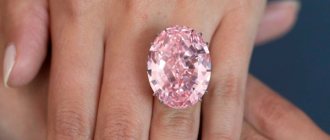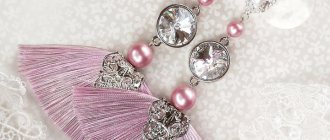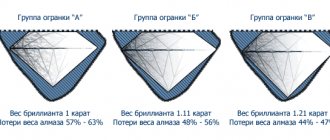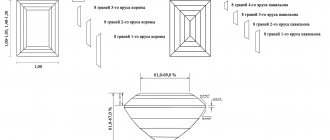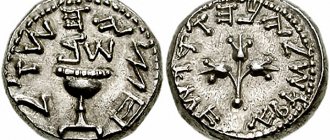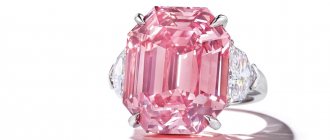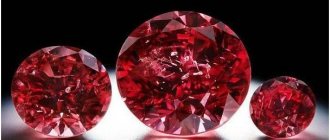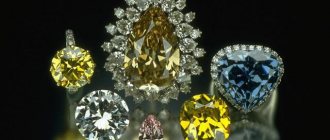Maybe someone you know likes old European cut diamonds. But what is the Old European Cut (OEC) and how can you find the perfect stone for your engagement ring? This guide will teach you everything you need to know about these diamonds.
This unique and striking ring features an antique European cut diamond
Finding a good looking antique European diamond can be difficult. You will have to work closely with a reputable antique dealer or jeweler.
What is an antique European cut diamond?
As you might guess, these diamonds are cut in a style developed in Europe and popular from 1890 to 1930. If you find an antique round diamond ring from this period, it is most likely an antique European cut, often referred to as an "OEC".
Earlier diamonds were usually the so-called "old mine cut", while later ones were the well-known modern round brilliant.
Content
- Features and benefits of the stone Symbol of endless love
- Who is it suitable for?
- Engagement
- Class differences
- Differences between classes
Old Europe versus modernity
There may be many reasons why you want to use an old European cut diamond instead of a modern round brilliant. However, there are reasons why the modern cut has surpassed the old cut in popularity. Ultimately, choosing one over the other will depend on your personal style and preferences. However, you should consider the following factors.
Fire vs spark
The biggest visual difference between an antique stone and a modern round diamond is that the old cut promotes scattering, or “fire,” multi-colored flashes of light within the stone. The modern round diamond maximizes brilliance and sparkle, creating the distinctive black and white pattern you see on the surface.
Art Deco engagement ring with 1.39 carat European cut diamond centerpiece, circa 1920
14k gold solitaire ring with 2ct modern classic cut diamond
The two cuts also reflect light in different styles. Antique diamonds have a larger light pattern, while modern diamonds have a more sparkling pattern with more sparkle or reflection of white light.
Handmade and machine cut
Machine cutting was not available in the days of antique European cut diamonds. Each one was carved by hand. You might think this means superior craftsmanship, but in reality it speaks to the uniqueness of each stone. Some will also have more quirks than others.
For example, some old European styles are non-round with odd bulges. Others have asymmetry in the edges.
This 1.4 carat OEC diamond has unusual bulges and part of the crown curves inwards
Meanwhile, modern cuts are much more uniform. While they vary somewhat in angles and are not all perfectly round, you can easily find one without noticeable bulges or asymmetry.
Antiques versus classics
Although the Old European cut was once the most popular, its heyday is long past. By age, such diamonds are classified as antiques. Of course, this gives them a charm that modern diamonds do not have.
James Allen Two Tone 14K Gold Solitaire Engagement Ring Set with a 1.02ct Contemporary Round Diamond
However, the modern cut is a classic in its own right. For decades, it was the most popular diamond cut. When someone talks about an engagement ring, most people probably think of the modern round diamond.
Rare or easily available
From a practical standpoint, even finding an old European cut diamond can present some challenges. There just aren't many of them and they don't come to market very often. And those that do appear are more likely to have features due to their age. The quality of these diamonds can also vary greatly.
In contrast, modern round diamonds are readily available. You can quickly find a quality gemstone.
Cut details
Most older diamonds were cut to retain more weight rather than to improve appearance. Due to the shape of rough diamonds, the end result was a deep cut with a high crown and a small table. Old diamonds also often had a flat edge instead of a point. This not only protected the bottom from chips, but also gave them a distinctive look.
In this image you can see a circle right in the center of the stone
Greater depth and steeper crown angles allow these diamonds to reflect more fire. This effect is similar to a prism creating a rainbow from sunlight. When light passes through a diamond, it is separated into its component colors, each of which bends a different amount. The colors are then reflected back into your eye. Because light travels further into a deeper diamond, you get more fire.
Here you can see the cool high crown of an old European cut
However, this greater depth also means that there is more light leakage in the old European cut. These diamonds simply won't look as vibrant as modern round diamonds. They will show less white light.
Causes of infection
The main pathogenic factor is direct contact with the infectious agent. Infection with tapeworm occurs when eating low-quality meat and offal in the diet, but systematic violation of personal hygiene rules should also not be ruled out. To avoid invasive infection, each person needs to carefully study the etiology of the pathological process. The triggering factors for tapeworm are:
- home living conditions (social and household factor);
- consumption of contaminated water, bites of infected insects (environmental factor);
- poor quality washing of raw vegetables and fruits, violation of the rules for heat treatment of meat and fish dishes.
How to buy an antique European cut diamond
If you're set on the old European version, you'll have to do some work. Unlike a modern diamond, the old European cut does not have specific parameters. You will have to judge the beauty of the stone yourself and rely on the experience of your jeweler or dealer.
Look for symmetry
First, if you want a high-quality antique European cut diamond, it must be symmetrical.
Find a circular outline and check the length to width ratio. Odds below 1.1 are worth considering, but 1.05 or below is excellent. Anything above 1.1 will be noticeably distorted and likely have a bulge.
This OEC diamond in platinum ring has a prominent bulge on the right side, 2ct, VS2/H
Take a look at the diamond from the side. Turn several times. Also make sure there are no weird bulges. This may mean the stone was cut to retain more weight without improving performance. Avoid such stones. Otherwise, you'll pay more for a diamond that won't look as good as you might expect.
Finally, look at the diamond from top to bottom, then from bottom to top. Make sure the edges are visually symmetrical. Asymmetrical facets will affect how the diamond reflects and refracts light, making it less attractive.
Evaluate its effectiveness
Then look at the diamond in different lighting. Natural sunlight, fluorescent lights in the office, and warm lamps you use at home all have different effects on the appearance of the stone. To see the color of a diamond as seen by gem graders, look at the stone under a daylight-equivalent light bulb with an ultraviolet component. This is the lighting standard for evaluating the color of diamonds.
Look at the play of white and colored light in a diamond. Flashes of light should dance across the stone and flicker.
Also look at the dark areas. Avoid diamonds with dark areas that cover more than 25% of the stone, regardless of viewing angle. This condition is called "extinction".
This antique European cut diamond shines brightly with white light
Notice the patterns of light and dark as you move the diamond. Often, older European cut diamonds have adjacent facets that darken at the same time. The best stones won't show this, but there are very few of them. You will likely end up with a diamond that has multiple facets that darken simultaneously at certain angles.
Diamond Grading Reports
Although gem grading laboratories do not provide a full report for Old European Cut diamonds, they do grade these stones based on color and clarity. Here are some tips to help you better understand their report.
Color
The classification of a white diamond indicates how colorless the diamond is. This grading system starts with the letter D, which is completely colorless, and assigns letters lower in the alphabet for diamonds with gradually increasing color, all the way up to Z for stones with a characteristic yellow tint. Diamonds that are bright yellow or any other color, such as pink or blue, are considered “fancy color” diamonds. These stones have a different color classification system.
The following guidelines apply to white diamonds
To make a modern round diamond in white gold or platinum appear colorless, we generally recommend a color grade of I or higher. To make a stone appear colorless in yellow or rose gold, we recommend a color grade of M or higher. Of course, modern round diamonds reflect a lot of white light. However, older European cut diamonds are not designed for this. They show more colored light. So, you may need stones that are one or two grades higher in color to achieve the colorless look of the antique European cut.
F is an unusually high color grade for OEC, like this 1.21 carat diamond set in white gold
Many old European cut diamonds have a lower color tone and a yellow or brown tint in any setting. This is why low color grade diamonds create a “vintage” vibe. They look more like stones that are usually associated with antiques!
This 4.86 carat antique European cut diamond certainly has some color. Art Deco, platinum solitaire ring
Chances are, the old European cut diamond you find for your ring will have a noticeable tint. If you are satisfied with this fact, feel free to make a purchase.
Purity
A diamond's clarity grade gives an idea of the number and size of defects in the stone. What really matters to consumers is whether any of these imperfections are noticeable to the naked eye and whether they weaken the diamond's crystal structure. Despite their classic scratch resistance, diamonds can still break or chip.
Old European cut diamonds with a high clarity grade of F, IF, VVS1 or VVS2 will certainly be clean on the eyes.
Medium clarity diamonds such as VS1 or VS2 will also be clear to the eye. Most SI1 and many SI2 clarity diamonds have no visible blemishes. However, you need to carefully examine all SI clarity diamonds before purchasing. Ask questions to sellers. They can point out flaws that may be difficult for you to notice. Do you still see flaws? Can you see them from the distance at which you would normally view the ring? Some consumers are very demanding about eye-clean diamonds. Others don't mind a stone with a subtle flaw, especially if it saves them money. The decision is yours.
Any low grade I diamonds may have visible imperfections as well as durability issues due to large imperfections. You must be prepared to spend a significant amount of time searching for a diamond of acceptable clarity I.
This SI2 clarity old European cut diamond has two black inclusions under the table where they are most visible. However, it is unclear whether they will be visible from normal viewing distances
What does a tapeworm look like in a person?
Having studied the structure and size of an adult, it is important to understand that the worm can live in the small intestine for a long time (up to 20 years), causing acute digestive upset. The tapeworm in humans is a hermaphrodite and can self-fertilize. It can lay up to a million eggs per day, so getting rid of such a parasite will not be easy. When removing it, the main thing is not to break it, otherwise the remaining segments in the intestines are capable of growth and the formation of an adult individual. To exterminate pathogenic flora, it is important to remove the tapeworm along with the head and all segments.
Diagnostics
To make a final diagnosis, a person needs a comprehensive examination. Diagnosis of tapeworm begins with testing, so you need to arm yourself with a sample of biological fluid, feces and go to the laboratory for further examination under a microscope. In the stool, the doctor can identify numerous segments, which eloquently indicate infection of the gastrointestinal tract. To identify large and mature individuals in the digestive tract, it is necessary to additionally perform an ultrasound of the abdominal cavity.
- Potatoes with mushrooms in a slow cooker: recipes with photos
- Respiratory chlamydia - pathogen, symptoms and treatment in children or adults
- Diet cheesecakes made from cottage cheese - recipes with photos step by step
Prevention of infection
To prevent tapeworm from appearing in the body, it is necessary to observe the rules of personal hygiene, and all food products must be subject to mandatory heat treatment. This way you can avoid treatment and serious complications in the body. The tapeworm starts in places where there are no sanitary standards, so a person must live in cleanliness and be clean. Other preventive measures are detailed below:
- Cooking food, especially meat and fish products, must be carried out at a temperature of at least 100 degrees.
- If the family has pets, they must be systematically wormed for prevention purposes.
- It is important to eliminate human interaction with rodents and harmful insects, which are potential carriers of pathogenic infection.
- It is important to teach children to wash their hands every time they come in from outside, before eating, and after visiting the toilet.
- Treatment of tapeworm in the body should begin in a timely manner, remembering its rapid reproduction in the walls of the small intestine.


